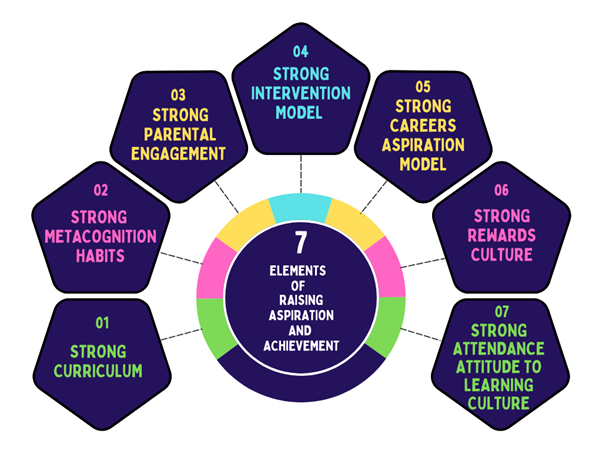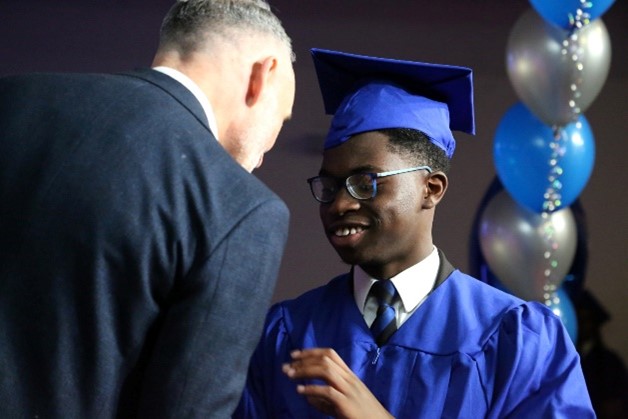Raising Achievement
Our vision for Raising Aspiration, Achievement and Attainment
We believe ‘High Expectations and Standards’ leads to high academic challenge and performance. It is our belief that there is 'no-excuse' to giving every learner, regardless of starting point, background or educational need, a body of knowledge and skills which can be demonstrated in a measurable way. This is done through an ambitious curriculum and a learning experience which secures life chances daily. We are clear that raising aspiration and achievement ultimately means improving life chances not just focusing on exams. Raising aspiration and achievement is all about giving learners the know-how to be ambitious, to learn the best ways for them to learn and giving them the academic and personal support to rise above barriers, particularly for our advantaged and vulnerable learners.
We believe that parental engagement is at the heart of this; research has shown that when parents are involved in their child's academic life, their chances of achieving success increase significantly. We strive to foster an atmosphere of collaboration between teachers, learners, and parents to ensure that everyone is working together towards a common goal.
There are 6 key strands that support our raising aspiration, achievement and attainment vision: See the diagram below:

Strategy Statement 1: Culture and Ethos - create an ethos of achievement by:
- Sustaining our belief that all learners, including the lowest attaining individuals, can achieve success
- Being ambitious for all learners and having high expectations of them daily both in lessons and on corridors
- Setting challenging tasks, adapted to meet needs, whilst maintaining an appropriate pace of learning
- Promoting a ‘can do’ mindset and attitude, an attitude that echoes ‘only your best is good enough’
- Responding promptly to evidence of under-achievement and evidence of success through aggressive monitoring CLICK HERE and formative assessments in class to allow for in the moment adjusting
- Using praise judiciously to motivate learners and to encourage them to value their own successes and respect the achievements of others
- Encourage parents and carers to engage with their children’s education
- Providing strong leadership and role models demonstrating a commitment to achieving high levels of success
- Using a range of strategies to reward learners
- Being intentional about teaching learners how to be resilient and independent learners through metacognitive practices
- Continuing to make comparisons against local and national benchmarks
- Recognising exceptional or outstanding achievement across subjects and key stages
 |
Strategy statement 2: Knowledge led, and outcomes driven- focus on outcomes for all learners and maximise success for all learners by:
|
- Involving learners in identifying clear and challenging targets, one-to-one quality academic conversations which encourages all learners to articulate their achievements
- Encouraging learners to become young academic experts in the making seeking to improve their body of knowledge ( our learners will leave SJA as young mathematicians, historians, artists etc)
Strategy Statement 3: Catch learners rising, falling or standing- Tracking, monitoring and intervening by:
- Ensuring a robust identification process that gives staff vital knowledge about learners who are rising, achieving and overachieving, learners whose learning is at risk of underperformance and learners who are coasting
- Gathering information from a range of sources to ensure we know our learners and how they perform well, including study habits, attitude to learning, academic health and well-being checks, tests etc
- Continuing to record, over time against key measures to allow for longitudinal observations about pace and progress in learning, in attainment and in wider achievement over time
- Extending the use of tracking to support interventions
- Providing support for our learners in class and outside of class
- Ensuring that intervention goes beyond an extension of curriculum time, intervention to us is time learners use to build their academic resilience and tenacity, further address gaps in knowledge to ensure their knowledge becomes secure, deliberate practice and utilise the support structures available
|
Strategy Statement 4: Effective Reporting on progress of individual learners will satisfy the following criteria:
|
 |
PARENTS ENGAGEMENT
As partners in their child's education, we believe that supporting learning at home is an important aspect of their overall success. There are many simple ways that parents can help with learning, even outside of the classroom. (See our One Page Parent Guide to boost aspiration, achievement and attainment.)
- Encourage them to read regularly: Reading is evidenced to be one of the most power indicators of future success. Reading will expose learners to a wider range of vocabulary over time.
- Discuss current events and new ideas: This could be as simple as a looking at current news articles on BBC news or talking about current events. Encourage oracy skills through this means.
- Provide opportunities to discuss learning: Swap roles and act as the learner, so children get the opportunity to explain what they have learnt.
Asking questions and providing positive feedback: Talking to your child about their learning, particularly what knowledge they feel secure about and knowledge that they feel less secure about, this helps to interrupt the Forgetting Curve we referred to earlier.
RESEARCH
Theory 1: Hattie’s concept of key influences related to learner achievement
In John Hattie’s Visible Learning for teachers: Impact on learning (Hattie 2012) shows Hattie's study which explored the influences that had the most and least impact on learner achievement. An effect size of 0.5 is equivalent to a one grade leap at GCSE. An effect size of 1.0 is equivalent to a two-grade leap at GCSE.
Theory 2: Sweller’s Cognitive load theory
John Sweller’s cognitive load theory describes how we learn using our ‘cognitive architecture’. Cognitive load refers to the amount of information the working memory can process at any given time. In the classroom, cognitive load theory helps us to avoid overloading learners with more than they can effectively process into schemas for long-term memory storage and future recall.
Theory 3: Ebbinghaus’ forgetting curve
Ebbinghaus’ forgetting curve shows how quickly we forget information over time if we make no attempt to retain it. In the classroom this presents an obvious challenge. To tackle this challenge, teachers need to understand what the forgetting curve is, and more importantly, the impactful strategies to overcome it.
Theory 4: Metacognition and Self Regulated Learning
The EEF evidence indicates the use of ‘metacognitive strategies’ – allowing learners think about their own learning – can be worth the equivalent of an additional +7 months’ progress when used well.